Wondering how to create a DeFi app?
Well, with the right guide, you can continue with its creation process. You don’t need to wander anywhere.
In this blog, you can find it all. Here we will discuss the attributes related to the DeFi ecosystem, working process, types, challenges, cost, reasons, monetization strategies, and steps.
Shall we start the journey?
Understanding the DeFi Ecosystem
Before we proceed to the guide for creating a DeFi app, let’s understand its nuances and basics.
DeFi applications are designed in a manner to provide an interface that automates the transactions among users by providing them with options to select the best.
It is a short-term for decentralized finance, which represents an umbrella for financial services over public blockchains. Through DeFi, people can perform most of the things that banks usually support of earning interest, borrowing, lending, trade derivatives, trade assets, and much more.
When it comes to the DeFi ecosystem, it is all about stablecoins, decentralized exchanges, and money markets along with any other financial products and services that are created through smart contracts and live within the environment of blockchain.
The finance app does it much faster and doesn’t require any paperwork or integration with a third party. These apps are designed to communicate with the blockchain, assisting people to utilize their money for performing purchases, loans, trading, gifts, or the way they want without any third party.
Now, let’s move on to the market stats of DeFi:
- The market size of DeFi is estimated to be USD 46.61 billion in the year 2024, and it is forecasted to reach USD 78.47 billion by the year 2029. The market is growing at a CAGR of 10.98% during the forecasted period (2024-2029).
- The global decentralized finance (DeFi) market size was valued at USD 13.61 billion in 2022. It is further forecasted to expand at a CAGR of 46%.
- Projected revenue in the DeFi market is expected to reach US $418.7 billion by the year 2024.
- Additionally, the market growth is driven by digital currency usage and is projected at USD 48.02 billion by the year 2031.
- According to data by SkyQuest, the global Decentralized market (DeFi) is Valued at $22 billion in the year 2022, which is further projected to grow to $48 billion by the year 2031.
Still trying to figure out the reasons, let’s switch to the next section.
Why Develop a DeFi App in 2025?
To proceed with the section on “how to develop a DeFi App, it’s important to answer “why”
Here are certain reasons to note:
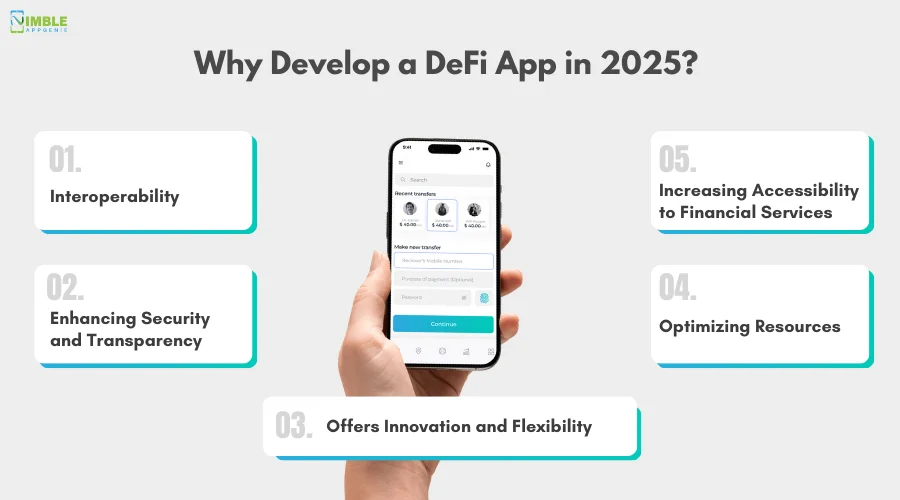
1. Interoperability
Creating a DeFi app is helpful for you as it can successfully align with the other products and systems. In the current era, financial apps should be synced with other apps for availing effective services to the target users. This can be a vital reason for continuing with DeFi app development.
2. Enhancing Security and Transparency
When creating a DeFi app, you will need to adopt multi-factor authentication and securely store the private keys that help to protect the user’s funds and data. Additionally, you will help in keeping the data of the user safe with the app. Here, you can add smart contracts acting as the backbone of DeFi apps.
3. Offers Innovation and Flexibility
DeFi platforms are at the forefront of financial innovation, offering new financial products and services including yield farming, liquidity mining, and synthetic assets. Businesses might have more flexibility and independence within their financial dealings through these features.
4. Optimizing Resources
DeFi app development will be helpful to merchants who are bothered by the banks, charging huge interest for any digital transactions. Creating DeFi apps can assist these merchants in having a platform where they can directly interact with the blockchain-powered platforms and reduce their operational costs.
5. Increasing Accessibility to Financial Services
Creating DeFi apps further can be useful in increasing the accessibility of financial services. This is one of the important reasons to continue with these protocols. This assists the users to directly participate in financial activities without any kind of intermediaries. With the assistance of this approach, businesses can lower costs and may broaden access.
These are all the reasons to consider for your DeFi app creation. Well, as you have decided to create a DeFi app, it’s essential to know its working procedure.
How Does DeFi App Work?
The working procedure of the DeFi app is essential to examine before planning the launch. DeFi may be a strange concept to you, however, people are using the platform in day-to-day aspects. Peer-to-peer lending can be considered as one of the prompt examples.
Under this process, the businesses don’t need to visit the banks. The system of DeFi works similarly to that of banks.
Check out the given steps for more info:
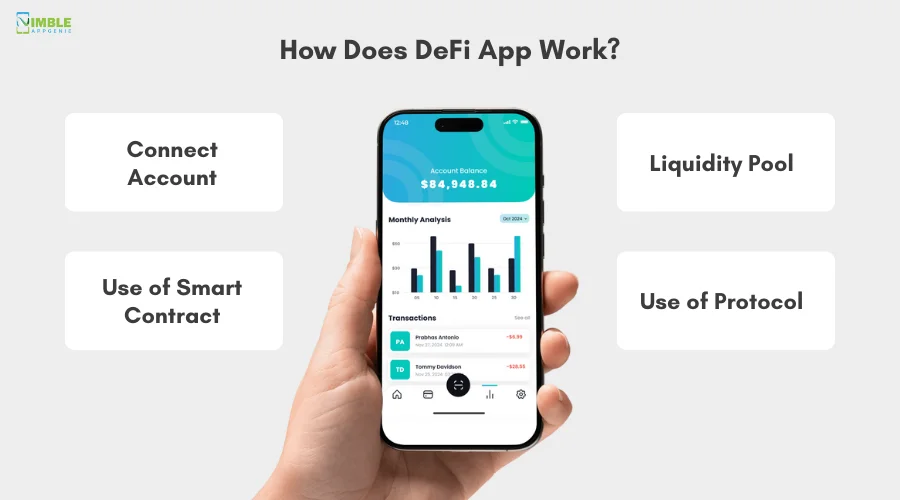
♦ Connect Account
Within the first step, the users are required to link their accounts with the application.
Other than this, users can directly deposit the funds to the DeFi app without involving any bank.
♦ Use of Smart Contract
With the help of blockchain technology, the app helps the users to connect with the expected lenders.
Smart contracts assist in connecting two parties comprised of end users and entities, in the form of computer code which is programmed for executing the platform automatically through a custom RPC for optimized transactions.
♦ Liquidity Pool
Through a liquidity pool, users can continue with their pledges on the protocols while building in the smart contract.
It is all connected through blockchain technology, where the transaction arrives at the distributed databases.
♦ Use of Protocol
Through the protocol, users can borrow money by pledging collateral to an individual or group.
Here, you might borrow money in crypto and create a digital contract between the lender and the borrower.
These are all important steps to consider when creating a DeFi app.
Well, after learning their steps, let’s consider the types of DeFi apps below.
The Main Types of DeFi Apps
It is vital to look for the diversified types of DeFi apps prior you reach the scaled solutions.
Here is a list of types to consider:
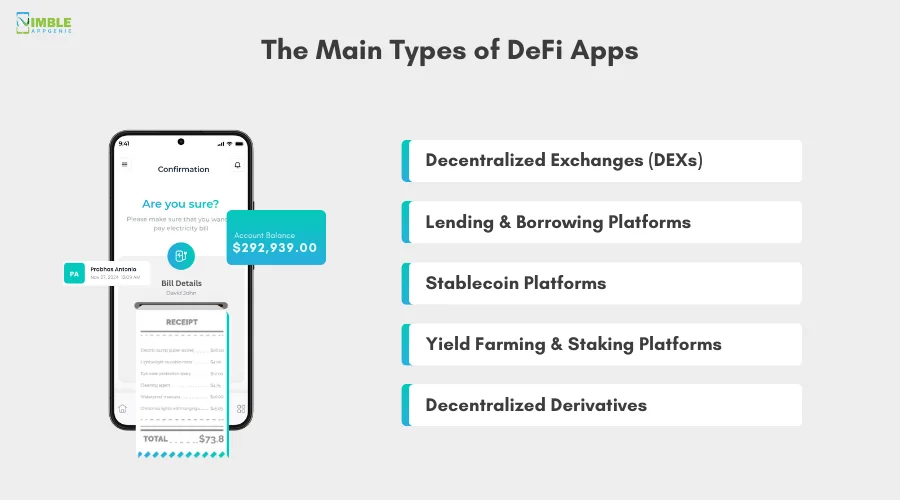
► Decentralized Exchanges (DEXs)
Decentralized exchanges are all about assisting users to trade in crypto assets via blockchain transactions without any need for a centralized intermediary. This type of application can help users trade crypto assets via blockchain transactions without any need for a custodian intermediary.
► Lending & Borrowing Platforms
DeFi lending is quite similar to the old lending services that are offered by the banks. The only difference here is that this type of app offers P2P decentralized applications. These platforms are designed to help people borrow and lend funds, and allow the crypto holders to earn an effective amount of income.
► Stablecoin Platforms
Stablecoin platforms offer digital assets that are well-designed to maintain a stable price over time. Within Stablecoin DeFi apps, cryptocurrencies are pledged to stable assets. These can be determined as platforms where the value is pegged and then tied to another currency, commodity, or financial statement.
► Yield Farming & Staking Platforms
Under this type of DeFi app, Yield farming and liquidity mining can be determined as a short-term investment. Energy is a high-risk, volatile investment where the investor can lend, borrow as well as lock the crypto assets. This is an advanced type, where the users are allowed to receive rewards through allocating digital assets.
► Decentralized Derivatives
Decentralized derivatives DeFi apps provide permissionless access that allows anyone to participate without needing permission from a central authority. This type of DeFi app can be useful in addressing the issue of the users related to approval of loans from the central authority and reduces the hassle of visiting banks or main branches of these banks.
After evaluating the types, you might be bothered about the steps, right?
Now the question is “How to design and launch a DeFi app?”
How to Design and Launch a DeFi Application? Step-by-Step
To develop a DeFi app, it’s vital to continue with the process and successfully. Let’s check it out all here.
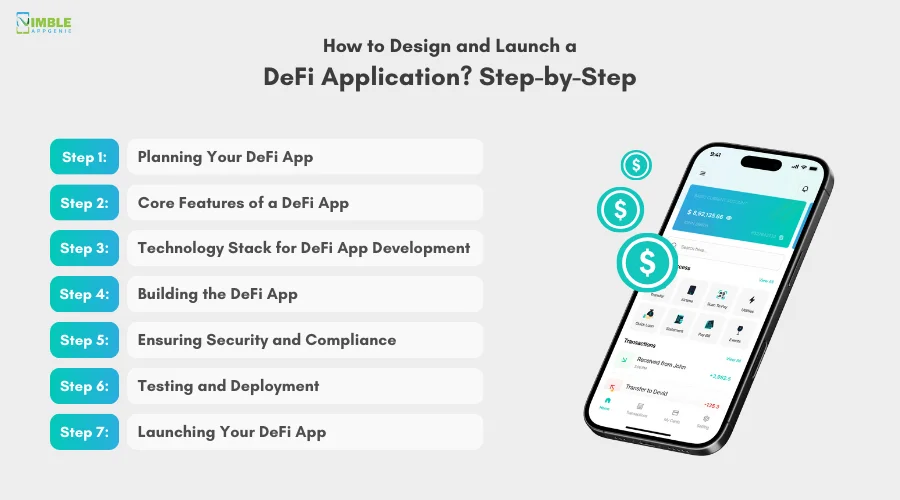
Step 1: Planning Your DeFi App
It is important to develop the project objectives and ensure that your DeFi app is capable of achieving them. You should be able to conduct in-depth market research to determine the target market as well as build a distinct value for the app.
Based on the very first step of DeFi app creation, you should identify the specific problem that exists in the market and understand the target audience.
Here, you can identify the specific DeFi use case that you further wish to address with the app. All you need is to conduct surveys, and focus groups, along with competitor analysis. You should clarify the target segment and then proceed with the app, effectively.
Step 2: Core Features of a DeFi App
You cannot imagine an app without its features, right? Thus, evaluating the type of features is a crucial determinant. The key principle behind DeFi is to remove third parties like banks from the financial system.
Here is a list of the top DeFi app features:
♦ Smart Contracts
The DeFi mobile app has this core feature of utilizing smart contracts for automating financial transactions, through reducing human error risk. It enables functions such as loan processing and automated payments, along with decentralized governance.
♦ DeFi Lending Platforms
DeFi lending platforms assist users in earning interest on their cryptocurrency holdings by lending them to borrowers. It offers margin trading options and assists long-term investors in lending assets.
♦ Governance Tokens
Governance tokens provide users with voting power to influence protocol decisions. This feature is responsible for decentralizing control and promoting community-driven development.
♦ Permissionless
One of the crucial features of DeFi that can be helpful to grab attention is its permissionless nature. The app doesn’t follow the conventional principles of access that are followed in traditional finance.
♦ Transparency
Transparency is a feature that helps merchants and customers maintain trust in the DeFi app. Smart contracts published over blockchain and records of completed transactions do exist for review.
Well, adopting these fintech app features can be helpful here for building your dream DeFi app.
Step 3: Technology Stack for DeFi App Development
After adopting the right features, you should implement a suitable fintech app tech stack. Here’s a table to consider.
| Component List | Technologies and Tools |
| Frontend | React.js, Vue.js, Web3.js, Tailwind CSS |
| Blockchain | Solana, Polygon, the distributed ledger, smart contracts, and Ethereum |
| Programming Languages | Rust, Vyper, C++, Java, PHP, Golang |
| Testing and Security Tools | Slither, OpenZeppelin, Remix, MythX |
| Wallet Integration | Wallet Connect, MetaMask, Web3.js, Ethers.js |
| Development Tools | Alchemy, Infura, Truffle, Hardhat, Ganache |
| Oracles | Brand Protocol, Chain-link |
| Storage | Arweave, Interplanetary file system |
This is an effective table helpful for considering the development process of the DeFi app.
Step 4: Building the DeFi App
Now is the time to consider creating a DeFi app. Here you combine all the technologies and steps and proceed to make a complete fintech app.
You should evaluate the essential technologies, along with the right design. Along with this, here you will take into account the type of elements such as developer community support, security, transaction speed, and scalability.
The technology should be built by considering a user-centric interface. The platform makes use of security protocols, software, and connectivity along with hardware advancements.
Step 5: Ensuring Security and Compliance
It is important to develop a risk evaluation plan for identifying security patterns. You should continue with risk assessments, helpful for identifying the type of risk involved in your next DeFi app.
After analyzing, it is important to set up the fintech app security patterns and controls. Thus, you should adopt and implement robust security technology.
Here, it is important to utilize security compliance and related automated solutions. Under this pattern, you can check the current regulations and implement them successfully.
Step 6: Testing and Deployment
The fintech mobile app testing and deployment pattern is essential to carry out to ensure that the service provided by the app remains error and bug-free.
Under this step, you should develop the software, ensuring that it is integrable, and then finally deploy it, successfully.
You need to deploy the app on the decided platforms like Android, iOS, or Hybrid.
Step 7: Launching Your DeFi App
Now, it’s time to make the DeFi app available to the end user. You can opt for various mobile app marketing tactics, helpful to launch the project in the market.
It is important to launch the app on the pre-planned date because it will not keep your end users waiting and can aid in building a diversified and strong connection with the audience, successfully.
Here, you should evaluate the principles and every nuance related to the DeFi industry, and ensure that your app is effective in attracting users.
Well, after evaluating the steps, another crucial step to determine is the cost of creating the DeFi app. It is the most essential resource to consider.
Let’s consider the cost, in the following section:
How Much Resources Does It Take To Build A Defi App?
The average cost to develop a DeFi app can vary from $35,000 to $300,000, depending on diversified factors including complexity, features, and many other determinants.
Other than the cost to develop a fintech app, one of the essential components can be the time undertaken for building a DeFi app.
Here is a table to consider when determining “how much time does it take to make a DeFi App?”
| App Development Process | Time Zone |
| Market analysis | 1-2 Months |
| Feature Choice | 1-2 Months |
| Implementing Tech Stack | 2-3 Months |
| Building a Complete App | 1-2 Months |
| Ensuring Security and Compliance | 1-2 Months |
| Testing and Compliance | 1-2 Months |
| Launching App | 1-2 Months |
| Total Time Taken | 8- 15 Months |
Till now, we have discussed briefly the DeFi ecosystem, its market stats, reasons, types, working process, resources required, and the steps to build a DeFi app.
Now, it is essential to identify the streams of earning money. After all, the end goal of every established business is earning higher revenue.
Please consider the following section for the same.
How DeFi Applications Earn Money?
It is essential to consider the types of patterns for earning money via creating a DeFi app.
Here’s a list of fintech app monetization models to be considered.
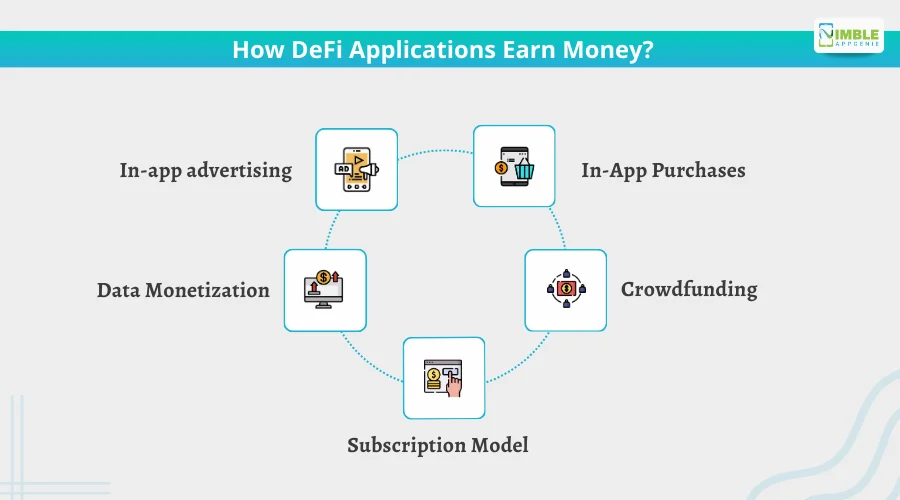
1] In-App Advertising
Through in-app advertising, you can connect with the clients and may charge an amount for posting their ads. This is one of the monetization frameworks that can help connect with the brands and have a permanent source of monetization.
2] In-App Purchases
With in-app purchases, you can allow the users to have a list of features that they can purchase according to their requirements. It’s all about the purchases that your end users can make to evaluate the new features. You can earn permanent revenue via this stream.
3] Data Monetization
Under data monetization, it is important to obtain consent from the users and then utilize their data for monetization purposes. This is the procedure, where the company-generated data might be utilized. However, the data should be exported via reports and Excel sheets.
4] Crowdfunding
Crowdfunding can be effective for your business, where you can fund a project or venture by raising small amounts of money from a large number of people via the Internet. For a DeFi app, you can raise quality funds, which may go towards a general donation.
5] Subscription Model
To build a DeFi app and earn revenue from the same, you can opt for the subscription model. It is a model where the users can sign up to pay for a premium version or subscription. Here, the user can connect with the business and you may adopt for permanent source of revenue.
These are all the strategies to undertake for earning money via building a DeFi app. After evaluating the monetization frameworks, you might be bothered about the type of challenges. Consider them all below.
Development Challenges in DeFi Apps
What are the development challenges that your DeFi app might face?
Check them all out below:
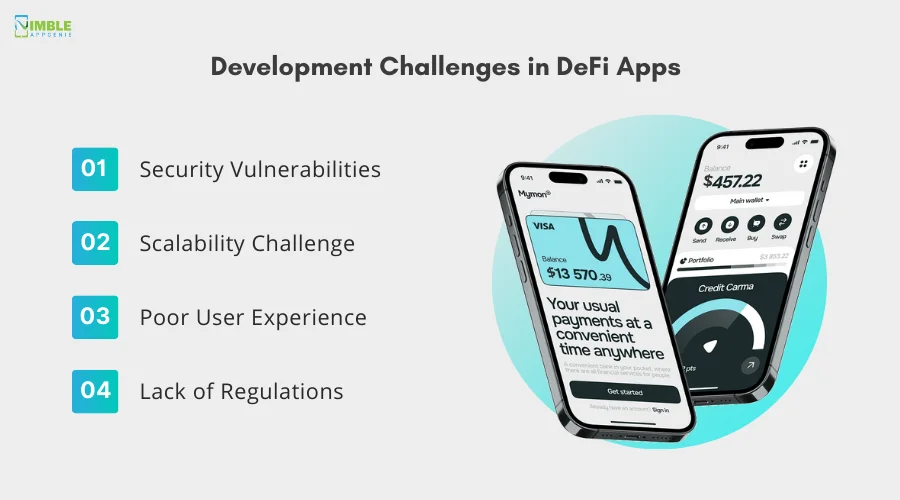
♦ Security Vulnerabilities
DeFi apps may face significant security concerns, due to the immature nature of the technology. Avoiding the issues related to security can result in hazards to the reputation of the brand.
DeFi apps often operate in an unregulated environment, which makes them susceptible to fraud and other malicious activities.
♦ Scalability Challenge
With low scalability and liquidity, the app can face a huge issue. During peak activity times, the network can become congested.
This can further lead to app crashes, disappointing the users to continue with the app. Scaling challenges might refer to difficulties and obstacles encountered when trying to improve the performance of the overall app.
♦ Poor User Experience
A bad user experience can result in negative reviews from the users. It might impact the complete brand image.
You cannot ignore the design of an app, as this will impact the user experience. Bad UX will result in slow-loading sites, frustrated users, and many more negative results.
♦ Lack of Regulations
If you are unaware of the regulations, you cannot succeed with your app. Thus, it’s essential to continue with the type of DeFi app, only after evaluating the current regulations of the industry.
You should evaluate severe sanctions, along with millions of dollars in fines. This will be effective in learning the issues to avoid while building a DeFi app.
These are all challenges to consider when building a DeFi app. You can connect with an experienced company to know more.
How Nimble AppGenie Can Help to Build a DeFi App?
At Nimble AppGenie, we are experts in providing and implementing cutting-edge technology solutions.
We are a leading Fintech App Development Company, offering diversified blockchain app development solutions.
Our team is ready to provide vision to your dream project and assist you in discovering various updated technologies for your DeFi app. in delivering quality and that too on time as per our commitment.
Conclusion
To develop a Defi app, all you need is the right series of steps, starting from market research to app launch and maintenance. Along with this, the tech stack to be used within DeFi app development can be Rust, Vyper, and C++, as programming languages, and for blockchain as Solana and Polygon.
There can be a series of challenges that your DeFi app might face including security vulnerabilities, scalability challenges, and lack of regulations. Here, the cost of creating a DeFi app might be impacted by different factors including complexity, app design, maintenance cost, and many others. Connecting with an experienced team can help you here.
FAQs

Niketan Sharma is the CTO of Nimble AppGenie, a prominent website and mobile app development company in the USA that is delivering excellence with a commitment to boosting business growth & maximizing customer satisfaction. He is a highly motivated individual who helps SMEs and startups grow in this dynamic market with the latest technology and innovation.
Table of Contents




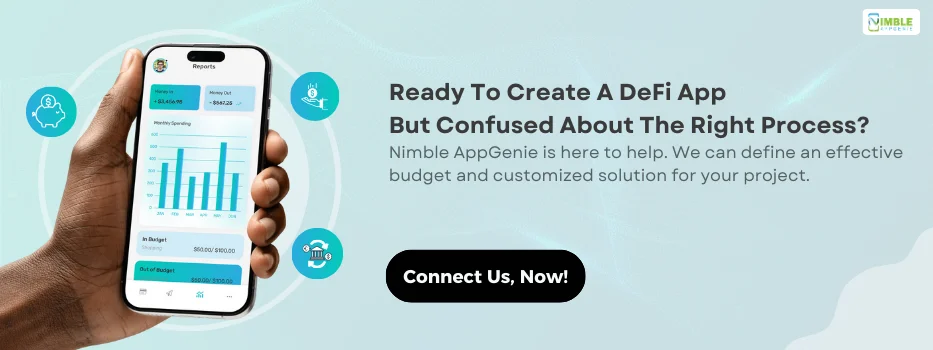
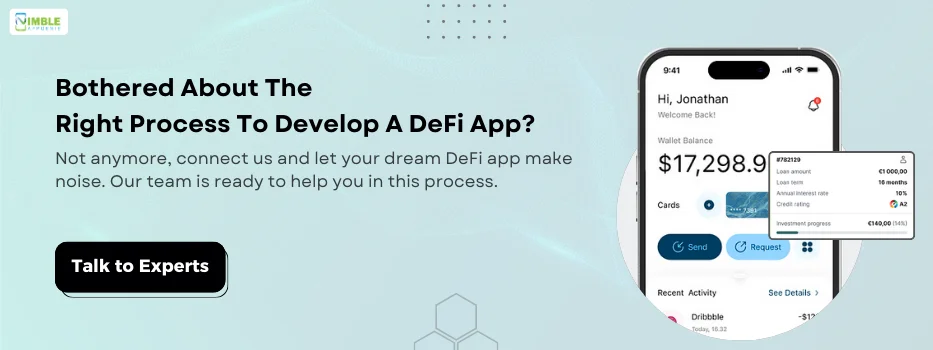
No Comments
Comments are closed.